Preparation of g-C3N4/Co3O4/NS-CQDs Composite Materials and Their Application in the Detection of Hydrogen Peroxide and Glucose
Abstract
1. Introduction
2. Materials and Methods
2.1. Materials
2.2. Preparation of Co3O4/NSC-g Composites with Different Morphologies
2.3. POD-like Activity Analysis
2.4. Steady-State Kinetic Study
3. Results and Discussion
3.1. Characterization of Co3O4/NSC-g Composites
3.2. POD-like Activity Studies of Co3O4/NSC-g Composites
3.2.1. Validation of POD-like Activity
3.2.2. Steady-State Kinetic Studies
3.3. The Basic Mechanism of the Reaction
Determination of Free Radicals
3.4. Detection of Hydrogen Peroxide and Actual Samples
3.4.1. Detection of Hydrogen Peroxide
3.4.2. Detection of Hydrogen Peroxide in Milk
3.5. Detection of Glucose and Actual Samples
3.5.1. Detection of Glucose
3.5.2. Detection of Glucose in Urine
4. Conclusions
Supplementary Materials
Author Contributions
Funding
Data Availability Statement
Conflicts of Interest
References
- Chi, Z.; Wang, Q.; Gu, J. Recent advances in colorimetric sensors based on nanozymes with peroxidase-like activity. Analyst 2023, 148, 487–506. [Google Scholar] [CrossRef] [PubMed]
- Huang, N.; Wen, J.; Yi, D.; Wei, Z.; Long, Y.; Zheng, H. Colorimetric detection of ATP by inhibiting the Peroxidase-like activity of carbon dots. Spectrochim. Acta Part A 2022, 268, 120658. [Google Scholar] [CrossRef] [PubMed]
- Liu, T.; Zhang, X.; Fu, K.; Zhou, N.; Xiong, J.; Su, Z. Fabrication of Co3O4/NiCo2O4 nanocomposite for detection of H2O2 and dopamine. Biosensors 2021, 11, 452. [Google Scholar] [CrossRef] [PubMed]
- Li, G.; Li, H.; Wang, C.; Li, X. Colorimetric aptasensor for sensitive Glypican-3 detection based on Hemin-reduced oxide Graphene-Platinum@ Palladium nanoparticles with peroxidase-like activity. IEEE Sens. J. 2022, 23, 111–118. [Google Scholar] [CrossRef]
- Liu, H.; Wang, Z.; Jun, L.; Jin, L.; Yan, F.; Li, J.; Lv, K. Preparation of g-C3N4/NS-CQDs composites and their application in the detection of hydrogen peroxide and glucose. Microchem. J. 2024, 205, 111261. [Google Scholar] [CrossRef]
- Peng, D.; Yang, Y.; Que, M.; Ding, Y.; Wu, M.; Deng, X.; He, Q.; Ma, X.; Li, X.; Qiu, H. Partially oxidized MoS2 nanosheets with high water-solubility to enhance the peroxidase-mimic activity for sensitive detection of glutathione. Anal. Chim. Acta 2023, 1250, 340968. [Google Scholar] [CrossRef]
- Zhang, Y.; Yang, X.; Gao, Z. In situ polymerization of aniline on carbon quantum dots: A new platform for ultrasensitive detection of glucose and hydrogen peroxide. RSC Adv. 2015, 5, 21675–21680. [Google Scholar] [CrossRef]
- Zhai, H.; Bai, Y.; Qin, J.; Feng, F. Colorimetric and ratiometric fluorescence dual-mode sensing of glucose based on carbon quantum dots and potential UV/fluorescence of o-diaminobenzene. Sensors 2019, 19, 674. [Google Scholar] [CrossRef]
- Song, C.; Liu, H.; Zhang, L.; Wang, J.; Zhao, C.; Xu, Q.; Yao, C. FeS nanoparticles embedded in 2D carbon nanosheets as novel nanozymes with peroxidase-like activity for colorimetric and fluorescence assay of H2O2 and antioxidant capacity. Sens. Actuators B Chem. 2022, 353, 131131. [Google Scholar] [CrossRef]
- Wang, P.; Cao, L.; Chen, Y.; Wu, Y.; Di, J. Photoelectrochemical biosensor based on Co3O4 nanoenzyme coupled with PbS quantum dots for hydrogen peroxide detection. ACS Appl. Nano Mater. 2019, 2, 2204–2211. [Google Scholar] [CrossRef]
- Wang, J.; Hu, Y.; Zhou, Q.; Hu, L.; Fu, W.; Wang, Y. Peroxidase-like activity of metal–organic framework [Cu (PDA)(DMF)] and its application for colorimetric detection of dopamine. ACS Appl. Mater. Interfaces 2019, 11, 44466–44473. [Google Scholar] [CrossRef] [PubMed]
- Wang, W.; Yin, Y.; Gunasekaran, S. Oxygen-terminated few-layered Ti3C2Tx MXene nanosheets as peroxidase-mimic nanozyme for colorimetric detection of kanamycin. Sens. Actuators B Chem. 2022, 218, 114774. [Google Scholar] [CrossRef] [PubMed]
- Wang, Y.; Liu, X.; Wang, M.; Wang, X.; Ma, W.; Li, J. Facile synthesis of CDs@ ZIF-8 nanocomposites as excellent peroxidase mimics for colorimetric detection of H2O2 and glutathione. Sens. Actuators B Chem. 2021, 329, 129115. [Google Scholar] [CrossRef]
- Xie, X.; Chen, X.; Wang, Y.; Zhang, M.; Fan, Y.; Yang, X. High-loading Cu single-atom nanozymes supported by carbon nitride with peroxidase-like activity for the colorimetric detection of tannic acid. Talanta 2023, 257, 124387. [Google Scholar] [CrossRef]
- Zhao, X.; Lu, Z.; Ji, R.; Zhang, M.; Yi, C.; Yan, Y. Biomass carbon modified Z-scheme g-C3N4/Co3O4 heterojunction with enhanced visible-light photocatalytic activity. Catal. Commun. 2018, 112, 49–52. [Google Scholar] [CrossRef]
- Zhang, L.; Wang, J.; Zhao, C.; Zhou, F.; Yao, C. Ultra-fast colorimetric detection of glutathione by magnetic Fe NPs with peroxidase-like activity. Sens. Actuators B Chem. 2022, 361, 131750. [Google Scholar] [CrossRef]
- Rostami, S.; Mehdinia, A.; Jabbari, A. Intrinsic peroxidase-like activity of graphene nanoribbons for label-free colorimetric detection of dopamine. Mater. Sci. Eng. C 2020, 114, 111034. [Google Scholar] [CrossRef]
- Pan, Q.; Kong, Y.; Chen, K.; Mao, M.; Wan, X.; She, X.; Song, G. A colorimetric assay for the detection of glucose and H2O2 based on Cu-Ag/g-C3N4/ZIF hybrids with superior peroxidase mimetic activity. Molecules 2020, 25, 4432. [Google Scholar] [CrossRef]
- Xu, X.; Luo, P.; Yang, H.; Pan, S.; Liu, H.; Hu, X. Regulating the enzymatic activities of metal-ATP nanoparticles by metal doping and their application for H2O2 detection. Sens. Actuators B Chem. 2021, 335, 129671. [Google Scholar] [CrossRef]
- Lu, J.; Zhang, H.; Li, S.; Guo, S.; Shen, L.; Zhou, T.; Zhang, Y. Oxygen-vacancy-enhanced peroxidase-like activity of reduced Co3O4 nanocomposites for the colorimetric detection of H2O2 and glucose. Inorg. Chem. 2020, 59, 3152–3159. [Google Scholar] [CrossRef]
- He, Y.; Li, N.; Li, W.; Zhang, X.; Zhang, X.; Liu, Z.; Liu, Q. 5,10,15,20-tetrakis (4-carboxylphenyl) porphyrin functionalized NiCo2S4 yolk-shell nanospheres: Excellent peroxidase-like activity, catalytic mechanism and fast cascade colorimetric biosensor for cholesterol. Sens. Actuators B Chem. 2021, 326, 128850. [Google Scholar] [CrossRef]
- Chen, T.; Zhang, R.; Ye, B.; Yang, Q.; Xu, H.; Zheng, L.; Wang, L. Ce-doped CoP nanoparticles embedded in carbon nanotubes as an efficient and durable catalyst for hydrogen evolution. Nanotechnology 2020, 31, 125402. [Google Scholar] [CrossRef] [PubMed]
- Hu, K.; Li, J.; Han, Y.; Ng, D.H.; Xing, N.; Lyu, Y. A colorimetric detection strategy and micromotor-assisted photo-Fenton like degradation for hydroquinone based on the peroxidase-like activity of Co3O4–CeO2 nanocages. Catal. Sci. Technol. 2022, 12, 7161–7170. [Google Scholar] [CrossRef]
- Liang, H.; Zhu, H.; Zhang, M.; Hou, S.; Li, Q.; Yang, J. Oxygen vacancies promoted the generation of sulfate radicals and singlet oxygen by peroxymonosulfate activation with Co3O4 quantum dots/g-C3N4 nanosheets. Chem. Eng. Sci. 2024, 284, 119463. [Google Scholar] [CrossRef]
- Liu, X.; Cao, X.; Zhao, S.; Liu, Z.; Lu, G.; Liu, Q.N. S co-doped Co3O4 core–shell nanospheres with high peroxidase activity for the fast colorimetric detection of catechol. Anal. Methods 2021, 13, 5377–5382. [Google Scholar] [CrossRef]
- Yue, J.; Xu, J.; Hong, B.; Li, J.; Zeng, Y.; Gong, J.; Peng, X.; Ge, H.; Chen, H.; Wang, X. Synthesis and calcination-temperature-dependent gas-sensing performance of g-C3N4/Co3O4 heterojunctions for toluene gas sensors. J. Mater. Sci. Mater. Eletron. 2023, 34, 1572. [Google Scholar] [CrossRef]
- Pradhan, D.; Mohanty, L.; Singhal, R.; Falletta, E.; Dask, S. Sustainable and solar light assisted photocatalytic degradation of MB and MG dyes by Co3O4/g-C3N4 nanocomposite. Inorg. Chem. Commun. 2023, 156, 111259. [Google Scholar] [CrossRef]
- Shi, W.; Shuang, E.; Wang, M.M.; Li, T.Z.; Yang, T.; Liu, S.R.; Wang, J.H. Facile synthesis of metal–organic framework-derived SiW12@ Co3O4 and its peroxidase-like activity in colorimetric assay. Analyst 2019, 144, 5455–5461. [Google Scholar] [CrossRef]
- Nguyen, T.V.T.; Seo, Y.J. Highly sensitive fluorescent sensor targeting CuCl2 based on thiophene attached anthracene compound (TA). Tetrahedron Lett. 2017, 58, 941–944. [Google Scholar] [CrossRef]
- Ju, P.; He, Y.; Wang, M.; Han, X.; Jiang, F.; Sun, C.; Wu, C. Enhanced peroxidase-like activity of MoS2 quantum dots functionalized g-C3N4 nanosheets towards colorimetric detection of H2O2. Nanomaterials 2018, 8, 976. [Google Scholar] [CrossRef]
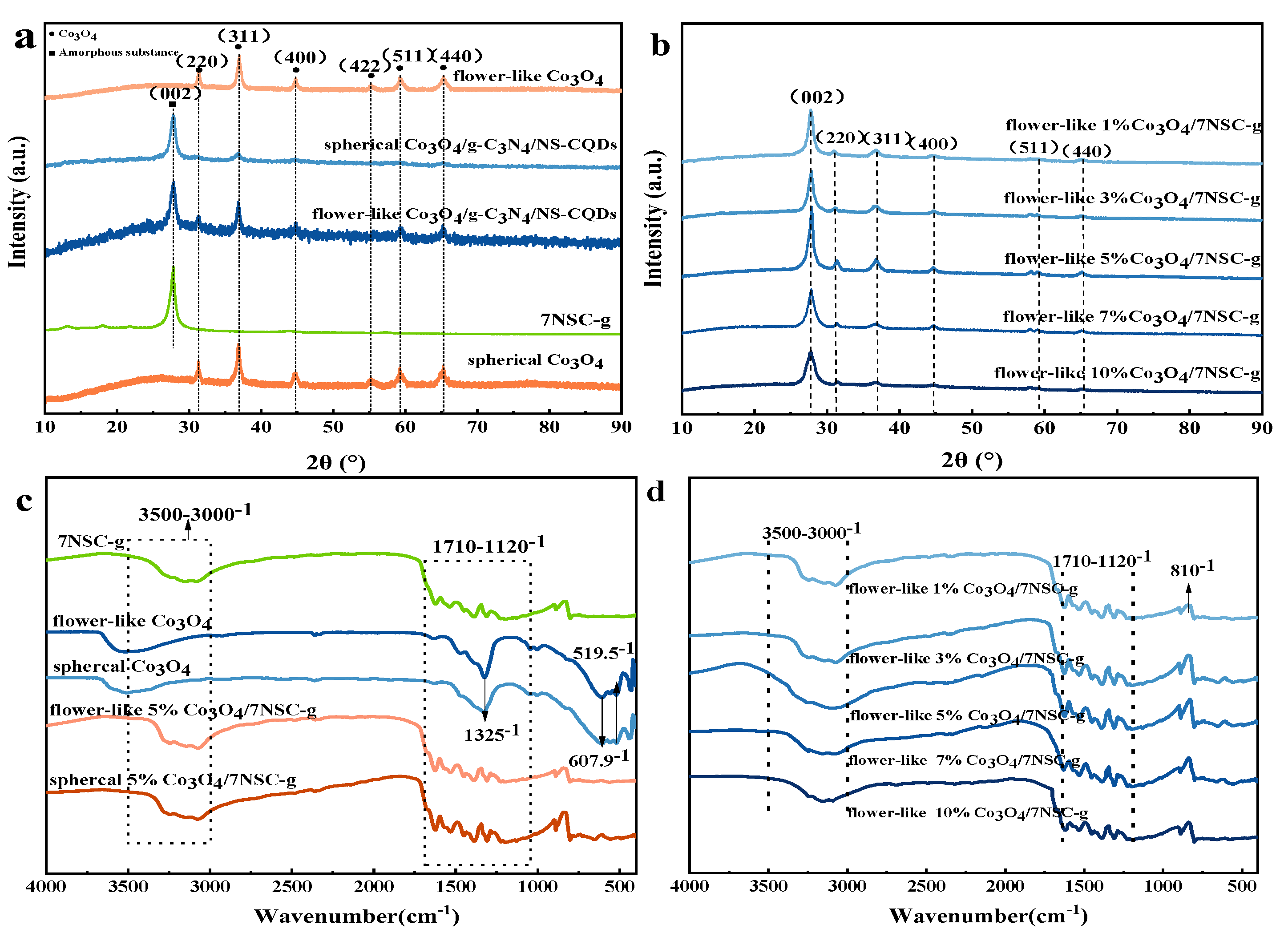
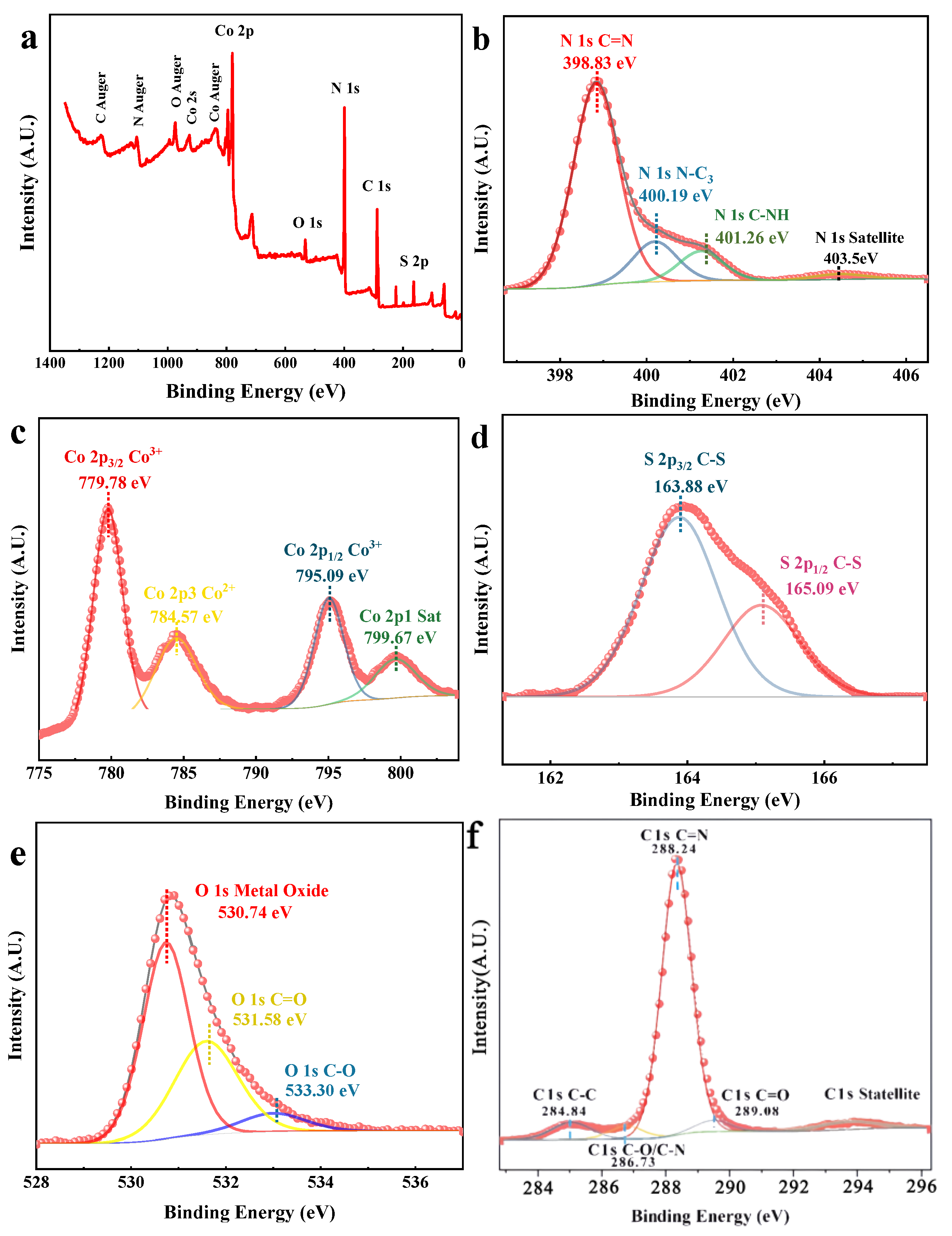

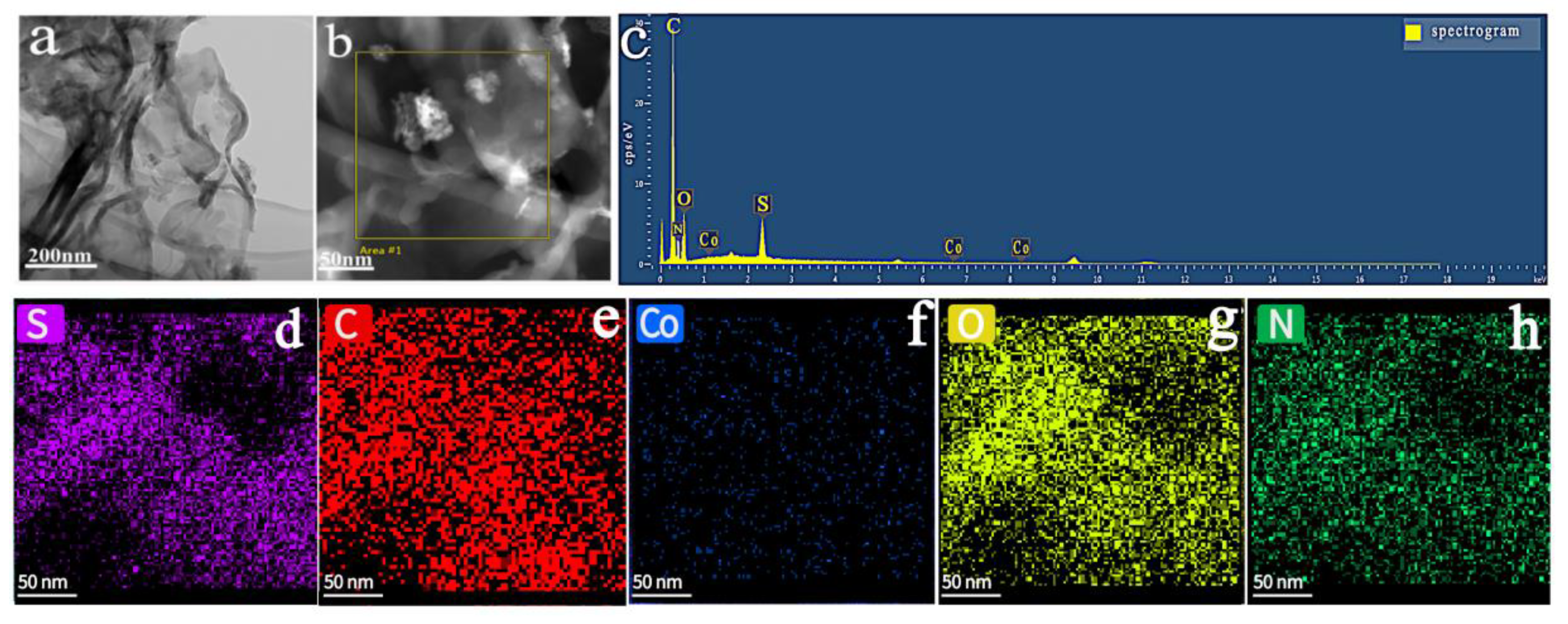


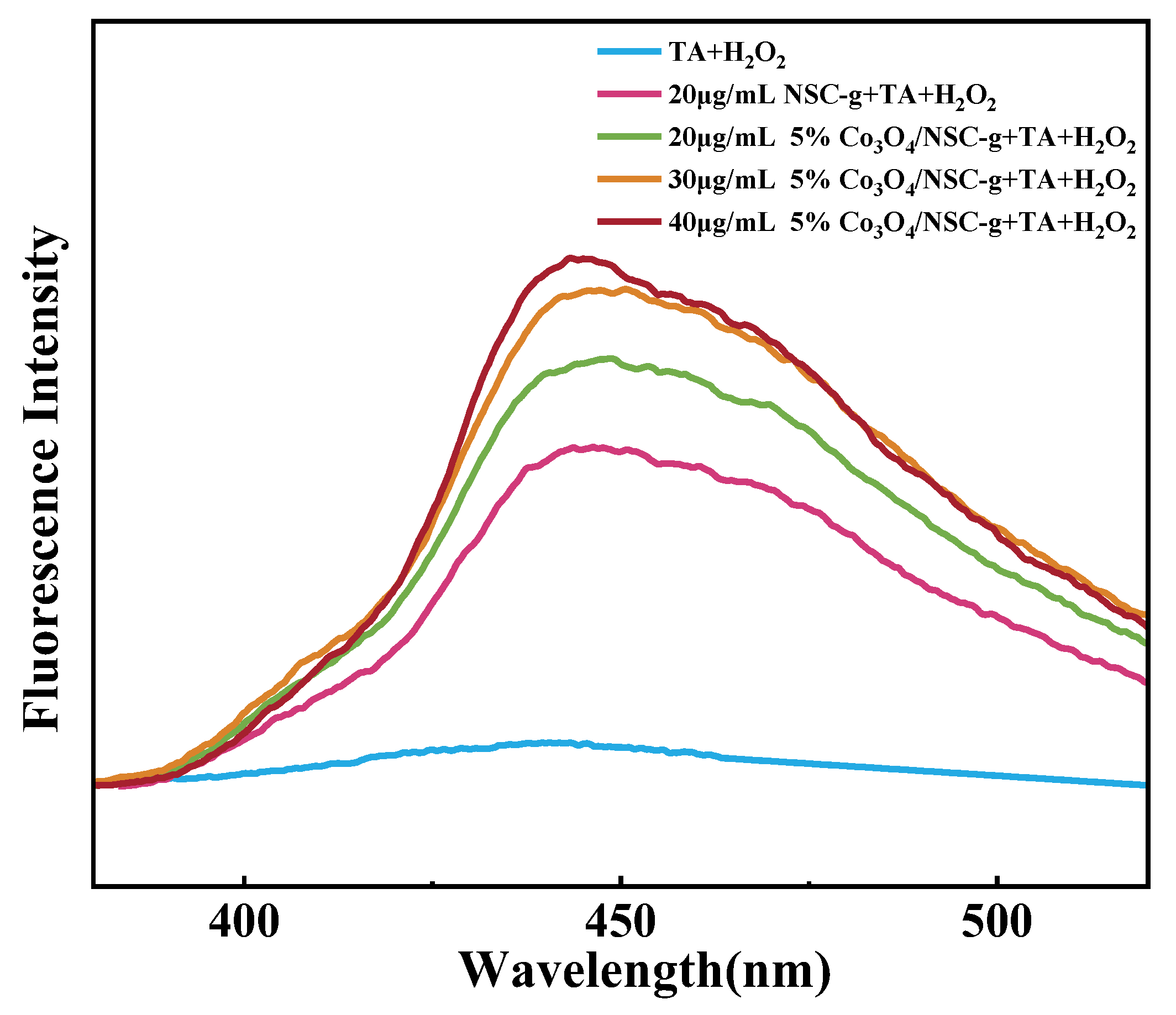
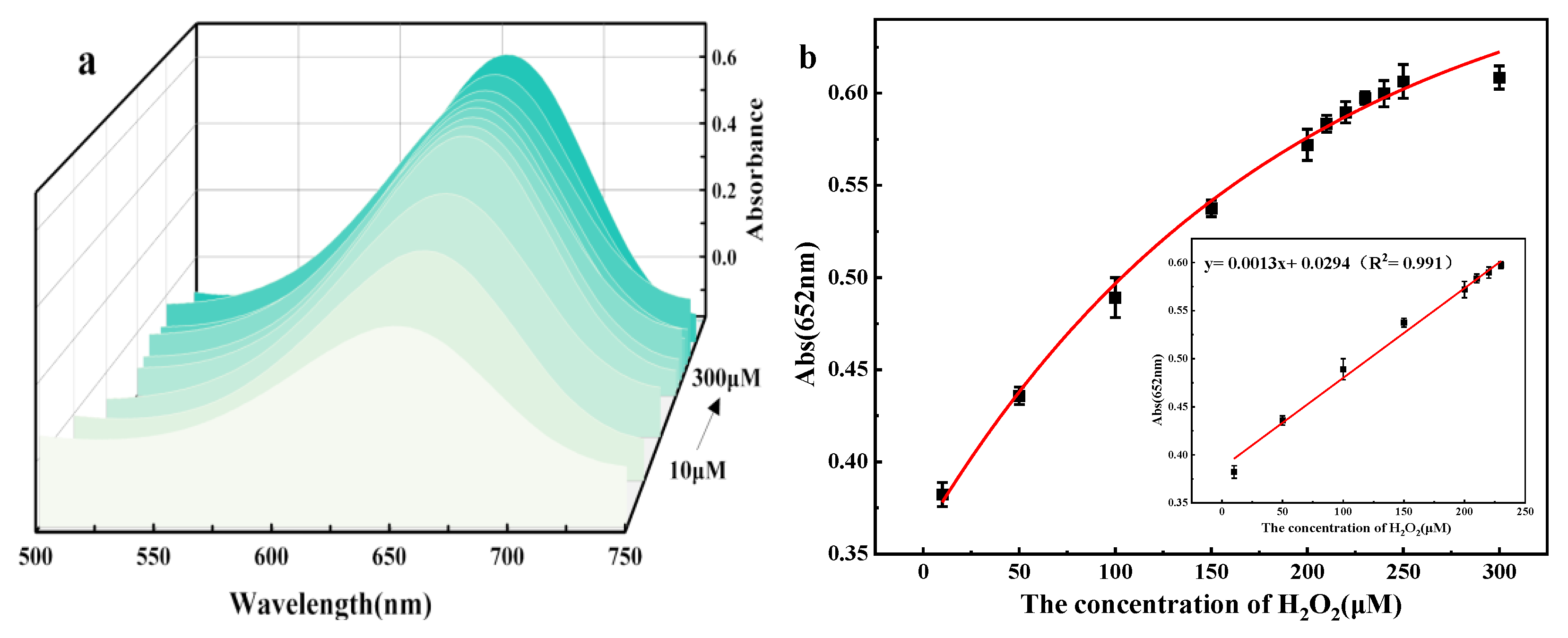
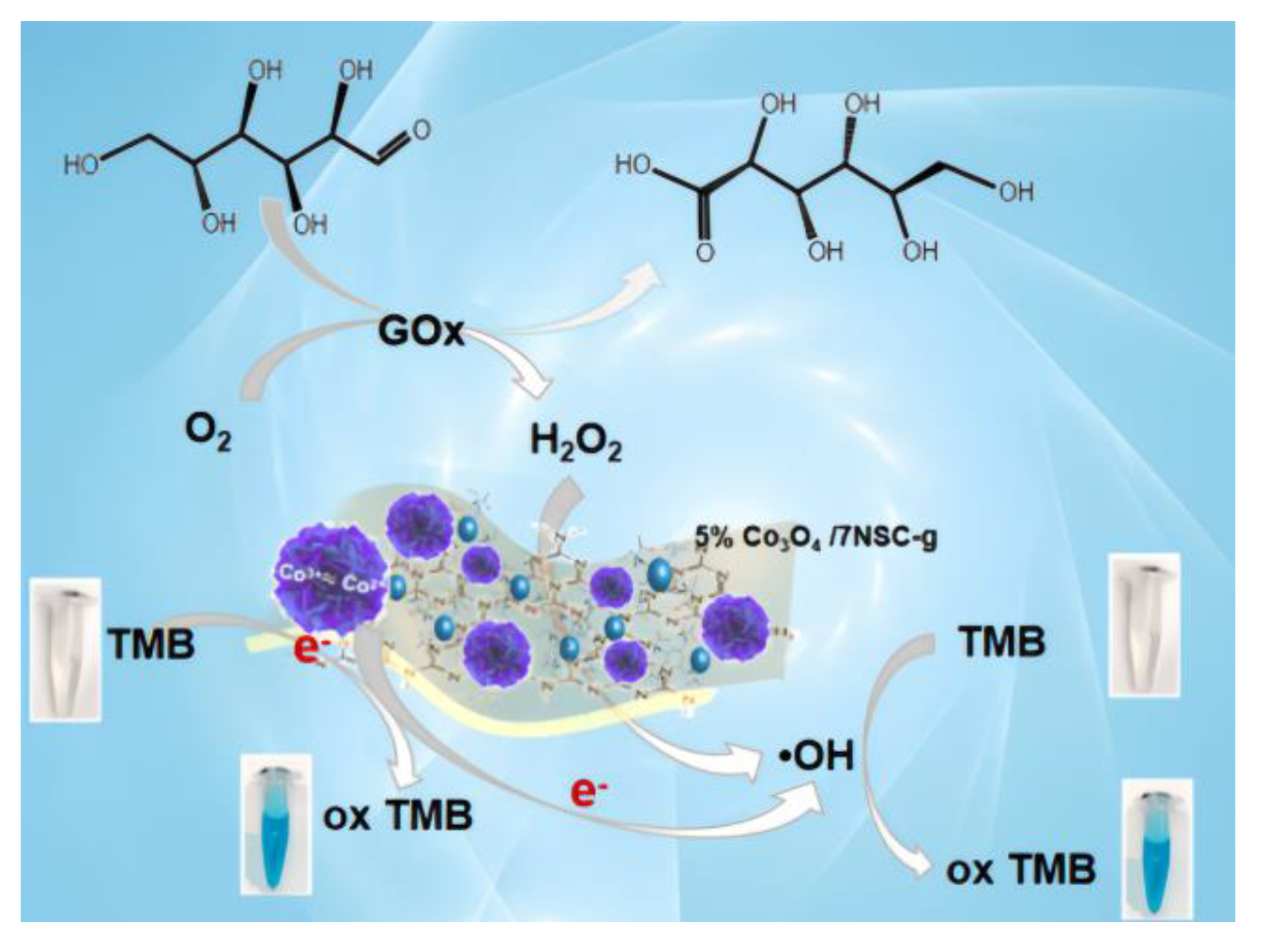
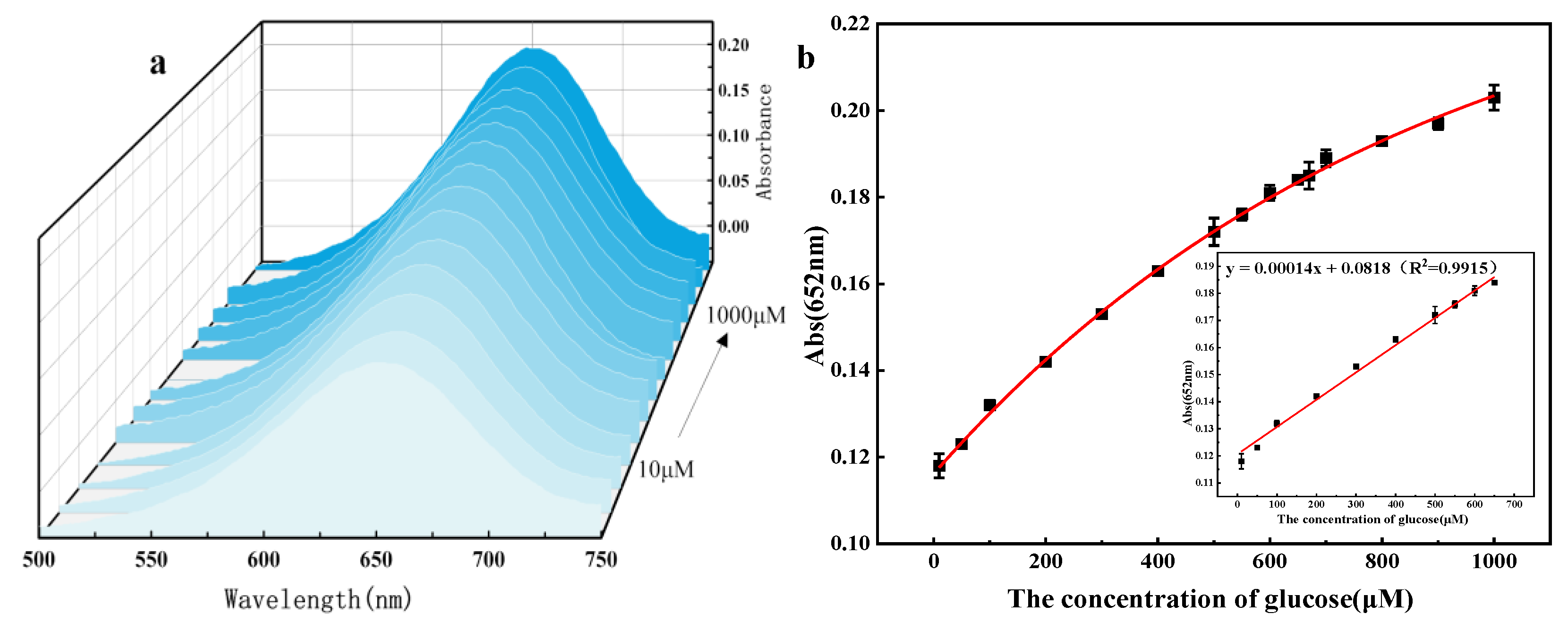
| Nanozymes | H2O2 | TMB | ||
|---|---|---|---|---|
| Km (mM) | Vmax (10−8 M·S−1) | Km (mM) | Vmax (10−8 M·S−1) | |
| NSC-g | 1.55 | 4.47 | 0.170 | 4.81 |
| Flower-like 5%Co3O4/NSC-g | 1.538 | 6.17 | 0.1164 | 5.78 |
| Added H2O2 (μM) | Found H2O2 (μM) | Recovered (%) | RSD (%) |
|---|---|---|---|
| 50.0 | 50.48 | 100.96 | 1.08 |
| 100.0 | 98.46 | 98.46 | 3.28 |
| 150.0 | 152.62 | 101.74 | 3.62 |
| Added Glucose (μM) | Found Glucose (μM) | Recovered (%) | RSD (%) |
|---|---|---|---|
| 50.0 | 50.48 | 100.96 | 1.08 |
| 100.0 | 98.46 | 98.46 | 3.28 |
| 150.0 | 152.62 | 101.74 | 3.62 |
Disclaimer/Publisher’s Note: The statements, opinions and data contained in all publications are solely those of the individual author(s) and contributor(s) and not of MDPI and/or the editor(s). MDPI and/or the editor(s) disclaim responsibility for any injury to people or property resulting from any ideas, methods, instructions or products referred to in the content. |
© 2025 by the authors. Licensee MDPI, Basel, Switzerland. This article is an open access article distributed under the terms and conditions of the Creative Commons Attribution (CC BY) license (https://creativecommons.org/licenses/by/4.0/).
Share and Cite
Feng, C.; Chen, Y.; Wang, W.; Niu, Y.; Cao, X.; Lv, Y. Preparation of g-C3N4/Co3O4/NS-CQDs Composite Materials and Their Application in the Detection of Hydrogen Peroxide and Glucose. Nanomaterials 2025, 15, 752. https://doi.org/10.3390/nano15100752
Feng C, Chen Y, Wang W, Niu Y, Cao X, Lv Y. Preparation of g-C3N4/Co3O4/NS-CQDs Composite Materials and Their Application in the Detection of Hydrogen Peroxide and Glucose. Nanomaterials. 2025; 15(10):752. https://doi.org/10.3390/nano15100752
Chicago/Turabian StyleFeng, Chang, Yufeng Chen, Weie Wang, Yanan Niu, Xi Cao, and Yuguang Lv. 2025. "Preparation of g-C3N4/Co3O4/NS-CQDs Composite Materials and Their Application in the Detection of Hydrogen Peroxide and Glucose" Nanomaterials 15, no. 10: 752. https://doi.org/10.3390/nano15100752
APA StyleFeng, C., Chen, Y., Wang, W., Niu, Y., Cao, X., & Lv, Y. (2025). Preparation of g-C3N4/Co3O4/NS-CQDs Composite Materials and Their Application in the Detection of Hydrogen Peroxide and Glucose. Nanomaterials, 15(10), 752. https://doi.org/10.3390/nano15100752





